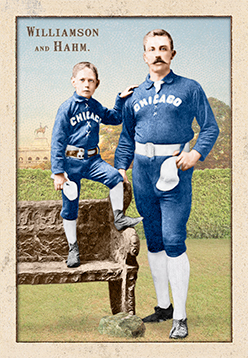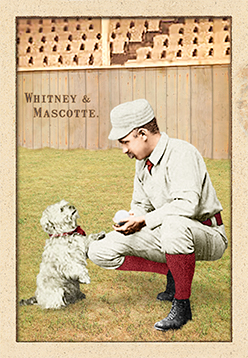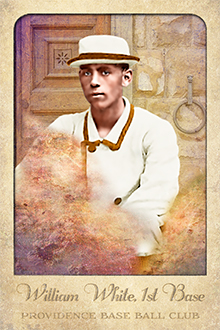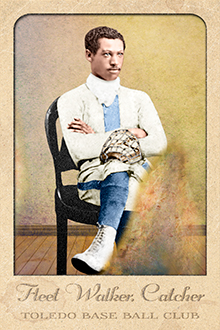
- Series: 1880s: Diamond Duos
- City: Chicago
- Team: White Stockings
- League: National League
Ned Williamson:
Edward Nagle Williamson (1857-1894). A 3rd baseman & shortstop for 3 teams over 13 seasons, Ned was an above average hitter & excellent defender (despite his portly physique). Ned held the single season HR record (27 in ’84) until topped by Ruth’s 29 in ’19. Ned’s career was shortened by a knee injury he sustained while participating in Al Spalding’s baseball world tour.
In 1894, the Reach Guide convened a panel of 11 former ballplayers, including HOFer Jim O'Rourke, to debate who was the greatest baseball player of all time. The panel concluded that the honor belonged to Ned Williamson. Cap Anson himself called Ned "the greatest all-around ballplayer the country ever saw."
- Won 5 NL pennants
- Played in two World Series
- Once owned single season doubles record: 49
Willie Hahm:
Willie Hahm, also known as “Master Willies,” was a rarity among early baseball mascots. He was white. The youngster, said to have been barely able to talk when first brought to the dugout, was the diminutive talisman for the Chicago White Stockings in the mid-1880s. “The Chicagos have great confidence in him as a promoter of success and make a great fuss over him” said Louisville Colonels manager Jim Hart in one of the earliest interviews explicating the curious role of mascots in America’s game. After triumphing in the 1884 campaign, Hart said the Sox had paraded Hahm at the head of their procession in an open landau. The Chicago Tribune reported on a big match with the rival Wolverines on June 18, 1886. Al Spalding brought a trainload of boosters to Detroit in hopes of preventing the eclipse of Chicago’s record home winning streak. Downtown Motor City was treated to the spectacle of the White Stockings and 200 rabid fans marching from the depot to the Russell Hotel carrying broomsticks with Willie Hahm leading the throng. Later, per the Tribune, “The Chicagos were escorted to the ground by a band, and entered the field behind little Willie Hahm, who carried an immense broom on which were written the words Our Mascot.”
- Many of the early mascots were black kids dragooned by superstitious players such as NY’s Buck Ewing
Artist's Note:
- The uniform colors on this card were changed in April, 2017 from black to blue to reflect recent reliable research by Craig Brown & friends at Threads of Our Game. Two cards were previously released featuring black uniforms.
Auction History
Cartophilia
Old Judge Pose: 502-7

- Series: Beginnings: 1880's
- City: Philadelphia
- Team: Athletics (AA)
- League: American Association
Harry Whitacre (aka Whiteacre, Whitaker) is known primarily from photographs: he is depicted on (at least) three 1888 Old Judge cards in an Athletics’ uniform. Harry was photographed batting and throwing right-handed. He is also found in a team photo of the Kennett Square Mohicans of 1886 along with the brothers of future major leaguer Mike Grady and the father of future Hall-of-Famer Herb Pennock. Kennett Square was becoming the “mushroom capital of the world” about the same time the Mohicans were transforming from an amateur club to one of the foremost teams in Pennsylvania in the late 1880s. The Sporting News, in January ‘88, touted “Whiteacre, the Athletics new pitcher” as being “highly thought of by Manager Sharsig.” As with many up-and-coming minor leaguers of the day, Harry’s promise went unfulfilled. He didn’t make the Philadelphia squad.
- The pose used on this card is one of two recently discovered Old Judge proofs of Whitacre, neither of which are known to have been issued in the original Old Judge series
- Baseball Encyclopedia records an H. Whitaker pitching one game for Williamsport of the Pennsylvania State Association in 1886, a complete-game win
- Although the Old Judge series features three known poses of Harry Whitacre, I could not find one of suitable quality for this project. This image is taken from an Old Judge proof taken at the same time as Whitacre's other OJ images and may represent an as-of-yet undiscovered pose.

- Series: 1880s: Diamond Duos
- City: New York
- Team: Giants
- League: National League
Art Whitney:
Arthur Wilson Whitney (1858-1943). Art played 3rd base for 8 different teams over 11 major league seasons. A below average hitter, his best year may have been 1886 with the Pittsburgh Alleghenys when he compiled 122 hits, 13 doubles, 4 triples, 15 steals & 70 runs with a light .239 batting average.
- 2x World Series Champion with the New York Giants: 1888 & 1889
- Although I haven't quite figured it all out, it appears Whitney was part of a fairly distinguished baseball family. His brother Frank played for the Boston Red Stockings in 1876; Charles Whitney, who played minor league ball from 1879 to 1889, was also likely Art's brother; and research suggests that 10 year major league veteran Grasshopper Jim Whitney may have been a cousin.
Mascotte:
This dog's name and relationship to Art Whitney and/or the New York Giants has been lost to history. I have no evidence that this dog ever served as the team's mascot, but she does appear to be wearing a handkerchief in the team's colors. The Giants (Buck Ewing in particular) were notoriously superstitious about their mascots. At one time or another between 1884 and 1890, the Giants "employed" at least five children: Masters Boldt, Bretsie, Preston, Breslin and an unidentified "colored boy," a yellow mongrel dog who was eventually captured by animal control and euthanized, and a toy rubber dog that barked when squeezed.
Despite the mystery surrounding this dog, her presence and photogenic posing created what REA has described as "one of the most unusual and memorable images to ever appear on a baseball card." It has been suggested that this image was staged and intended by the Goodwin photographers to represent a sort of comedic complex irony. Between the minor and major leagues, Art Whitney played for 12 different teams over 17 professional seasons and twice sued his team in contractual disputes. Even in an era when few players stayed with any one team for more than a year or two, Whitney's lack of loyalty was possibly renowned and cast into stark contrast in this photo by the adoring attention he is being given by man's best friend, the ever-loyal dog.
Whether the meeting between the two was devised or a genuine moment in time caught by a Goodwin photographer, I think the image's appeal is due to something simple we can all relate to: it's fun.
In fact, this is perhaps the image that most directly inspired the idea behind the Ars Longa 1880s series. In the nascent stages of my work, when this was all but an amorphous and rudimentary idea, I saw this image and thought how fun it would be to colorize it. Three and a half years and nearly 750 cards later, here it is.
Auction History
Cartophilia
Old Judge Pose: 499-1

- Series: Pioneer Portraits II: 1875-1899
- City: Providence
- Team: Grays (NL)
- League: National League
William Edward White (1860-1937) has been declared by the researchers at SABR to be the most likely “first black player” in major league baseball. White, the son of a Georgia merchant and his slave, played on the Brown University team and, on June 21, 1879, substituted for an injured Joe Start at first base for the Providence Grays. White’s stint in the big leagues for this National League squad lasted only that summer solstice. With his Brown teammates cheering from the stands, White went 1-for-4, stole two bases, scored a run and recorded 12 putouts without an error, drawing rave reviews from the local papers and contributing to a 5-3 win for the title-bound Grays and a 19 year old pitcher named John Montgomery Ward. Despite the Providence Journal reporting that White would continue to play first base for the team's next series against Boston, he was replaced by regular right fielder and Hall of Famer Jim O’Rourke, who continued to man the position until Start returned. White then stepped back into society where he passed for Caucasian. This is borne out by census records showing he claimed Rhode Island birth and being of white race.
- It has been suggested that White had always passed as white, thereby escaping suspicion in the baseball world and dodging "the virulent racism prevalent in the late 19th century." This may explain in part why the true identity of the first black ballplayer in major league baseball history went largely unknown for about 125 years.
- It is likely that White is the only former slave to play major league baseball.
- White’s death resulted from a fall on Chicago’s ice. His death certificate shows him to be Caucasian, affirming this mixed-race man spent a lifetime seeking to avoid the stigma of being black in Jim Crow America.

- Series: Pioneer Portraits II: 1875-1899
- City: Toledo
- Team: Blue Stockings
- League: American Association
Moses Fleetwood Walker (1857-1924) was likely not the first African-American to play major league baseball. For that distinction, historians have made a case for William Edward White, who played a game with the Providence Grays on June 21, 1879. Subbing for injured first baseman Joe Start, Bill White hit a single in four at bats, stole two bases, scored a run and recorded 12 putouts without an error, contributing to a 5-3 win for the title-bound Grays and a 19 year old pitcher named John Montgomery Ward. By the next game, White had been replaced at the position by regular right fielder and Hall of Famer Jim O’Rourke, who continued to man first base until Start returned. The historic event established a one game career in the major leagues for Bill White that predates Fleet Walker’s appearance by five years.
Fleet Walker became the second African-American major leaguer when he played for the Toledo Blue Stockings of the American Association in 1884. Toledo’s star pitcher was Tony Mullane, who considered Fleetwood “the best catcher I ever worked with.” Sadly, Mullane succumbed to the bigotry of his own and his day and, despite the negative consequences his maladaptive behavior bequeathed his team, repeatedly crossed Walker up by ignoring his signs. Mullane’s dangerous deceit led to a series of injuries for Fleetwood, including a season ending broken rib. Despite the difficulties and indignities, Fleet hit .263 on the year, which was a few ticks higher than league average.
Toledo went 46-58 in 1884, finished 8th in the league and folded at the end of the season. The graceful and talented Walker returned to minor league ball in 1885 and, when his playing days were past, led a noble life as an inventor, author and educator.
- Moses’ brother, Weldy Wilberforce Walker joined him in Toledo mid-season, becoming the third and last black player in the major leagues until Jackie Robinson appeared 63 years later. Weldy got into five games, played the outfield and hit .222 in 18 plate appearances.
- Hank O’Day was Toledo’s other pitcher in 1884, going 9-28 with a 3.75 ERA in 327 innings. Mullane was clearly the ace, going 36-26 with a 2.52 ERA in 567 innings. Ars Longa alumni on the team: Tony Mullane, Hank O’Day, Curt Welch, Tom Poorman & Deacon McGuire.
- Playing with the Newark Little Giants in 1887, Fleet Walker caught George Stovey, perhaps the best African-American pitcher of the 19th century. It was the first African-American battery in non-segregated professional baseball history. Ars Longa alumni on the team: John Henry, Mickey Hughes, John Irwin & Tom McLaughlin.
- On April 7, 1887, Walker caught Stovey in an exhibition game against the New York Giants, losing 3-2 to Tim O’Keefe. The 1887 Giants were a 19th century juggernaut, featuring Keefe, John Montgomery Ward, Roger Connor, Buck Ewing, Mickey Welch & George Gore among a host of other excellent players. John Ward was so impressed by the battery (and by Stovey in particular) that he convinced manager Jim Mutrie to sign the two. Legend has it that Mutrie did make an attempt to purchase the players’ contracts, and it’s not entirely clear why the transaction failed to materialize, but later that year the Sporting Life reported that the Brooklyn Bridegrooms were also trying to purchase Stovey’s contract.
- Just one year later in 1888, Fleet joined the Syracuse Stars and formed non-segregated professional baseball’s second African-American battery with pitcher Robert Higgins. Higgins was great, going 17-7 with a 2.76 ERA en route to an International League title for Syracuse. Ars Longa alumni on the team: Billy Serad, Con Murphy, Frank Gilmore & Cupid Childs.
- Walker endured the venom of Reconstruction Era racism. He resorted to alcohol to soothe the rage and the pain, contributing to a downward spiral that left him in despair of racial reconciliation.




